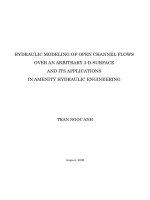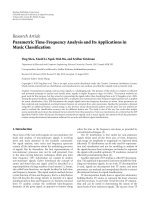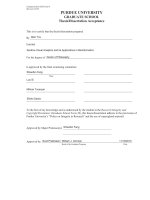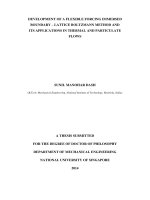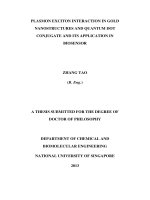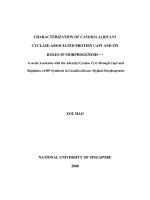Lecture Principles of economics - Chapter 5: Elasticity and its applications
Bạn đang xem bản rút gọn của tài liệu. Xem và tải ngay bản đầy đủ của tài liệu tại đây (520.7 KB, 44 trang )
Elasticity and Its
Applications
Copyright © 2004 South-Western
5
Elasticity . . .
• … allows us to analyze supply and demand
with greater precision.
• … is a measure of how much buyers and sellers
respond to changes in market conditions
Copyright © 2004 South-Western/Thomson Learning
THE ELASTICITY OF DEMAND
• Price elasticity of demand is a measure of how
much the quantity demanded of a good
responds to a change in the price of that good.
• Price elasticity of demand is the percentage
change in quantity demanded given a percent
change in the price.
Copyright © 2004 South-Western/Thomson Learning
The Price Elasticity of Demand and Its
Determinants
•
•
•
•
Availability of Close Substitutes
Necessities versus Luxuries
Definition of the Market
Time Horizon
Copyright © 2004 South-Western/Thomson Learning
The Price Elasticity of Demand and Its
Determinants
• Demand tends to be more elastic :
•
•
•
•
the larger the number of close substitutes.
if the good is a luxury.
the more narrowly defined the market.
the longer the time period.
Copyright © 2004 South-Western/Thomson Learning
Computing the Price Elasticity of Demand
• The price elasticity of demand is computed as
the percentage change in the quantity
demanded divided by the percentage change in
price.
P r ic e e la s tic ity o f d e m a n d =
P e r c e n ta g e c h a n g e in q u a n tity d e m a n d e d
P e r c e n ta g e c h a n g e in p r ic e
Copyright © 2004 South-Western/Thomson Learning
Computing the Price Elasticity of Demand
P r ic e e la s tic ity o f d e m a n d =
P e r c e n ta g e c h a n g e in q u a n tity d e m a n d e d
P e r c e n ta g e c h a n g e in p r ic e
• Example: If the price of an ice cream cone
increases from $2.00 to $2.20 and the amount
you buy falls from 10 to 8 cones, then your
elasticity of demand would be calculated as:
(1 0 8 )
100
10
( 2 .2 0 2 .0 0 )
100
2 .0 0
20%
10%
2
Copyright © 2004 South-Western/Thomson Learning
The Midpoint Method: A Better Way to
Calculate Percentage Changes and
Elasticities
• The midpoint formula is preferable when
calculating the price elasticity of demand
because it gives the same answer regardless of
the direction of the change.
(Q 2 Q 1) / [(Q 2 Q 1) / 2 ]
P r ic e e la s tic ity o f d e m a n d =
(P 2 P 1 ) / [(P 2 P 1 ) / 2 ]
Copyright © 2004 South-Western/Thomson Learning
The Midpoint Method: A Better Way to
Calculate Percentage Changes and
Elasticities
• Example: If the price of an ice cream cone
increases from $2.00 to $2.20 and the amount
you buy falls from 10 to 8 cones, then your
elasticity of demand, using the midpoint
formula, would be calculated as:
(1 0 8 )
22%
(1 0 8 ) / 2
2 .3 2
( 2 .2 0 2 .0 0 )
9 .5 %
( 2 .0 0 2 .2 0 ) / 2
Copyright © 2004 South-Western/Thomson Learning
The Variety of Demand Curves
• Inelastic Demand
• Quantity demanded does not respond strongly to
price changes.
• Price elasticity of demand is less than one.
• Elastic Demand
• Quantity demanded responds strongly to changes in
price.
• Price elasticity of demand is greater than one.
Copyright © 2004 South-Western/Thomson Learning
Computing the Price Elasticity of Demand
(100 50)
ED
Price
(4.00 5.00)
$5
4
0
Demand
50
67 percent
22 percent
(100
50)/2
(4.00
5.00)/2
3
100Quantity
Demand is price elastic
Copyright © 2004 South-Western/Thomson Learning
The Variety of Demand Curves
• Perfectly Inelastic
• Quantity demanded does not respond to price
changes.
• Perfectly Elastic
• Quantity demanded changes infinitely with any
change in price.
• Unit Elastic
• Quantity demanded changes by the same percentage
as the price.
Copyright © 2004 South-Western/Thomson Learning
The Variety of Demand Curves
• Because the price elasticity of demand
measures how much quantity demanded
responds to the price, it is closely related to the
slope of the demand curve.
Copyright © 2004 South-Western/Thomson Learning
Figure 1 The Price Elasticity of Demand
(a) Perfectly Inelastic Demand: Elasticity Equals 0
Price
Demand
$5
4
1. An
increase
in price . . .
0
100
Quantity
2. . . . leaves the quantity demanded unchanged.
Copyright©2003 Southwestern/Thomson Learning
Figure 1 The Price Elasticity of Demand
(b) Inelastic Demand: Elasticity Is Less Than 1
Price
$5
4
1. A 22%
increase
in price . . .
Demand
0
90
100
Quantity
2. . . . leads to an 11% decrease in quantity demanded.
Figure 1 The Price Elasticity of Demand
(c) Unit Elastic Demand: Elasticity Equals 1
Price
$5
4
Demand
1. A 22%
increase
in price . . .
0
80
100
Quantity
2. . . . leads to a 22% decrease in quantity demanded.
Copyright©2003 Southwestern/Thomson Learning
Figure 1 The Price Elasticity of Demand
(d) Elastic Demand: Elasticity Is Greater Than 1
Price
$5
4
Demand
1. A 22%
increase
in price . . .
0
50
100
Quantity
2. . . . leads to a 67% decrease in quantity demanded.
Figure 1 The Price Elasticity of Demand
(e) Perfectly Elastic Demand: Elasticity Equals Infinity
Price
1. At any price
above $4, quantity
demanded is zero.
$4
Demand
2. At exactly $4,
consumers will
buy any quantity.
0
3. At a price below $4,
quantity demanded is infinite.
Quantity
Total Revenue and the Price Elasticity of
Demand
• Total revenue is the amount paid by buyers and
received by sellers of a good.
• Computed as the price of the good times the
quantity sold.
TR = P x Q
Copyright © 2004 South-Western/Thomson Learning
Figure 2 Total Revenue
Price
$4
P × Q = $400
(revenue)
P
0
Demand
100
Quantity
Q
Copyright©2003 Southwestern/Thomson Learning
Elasticity and Total Revenue along a Linear
Demand Curve
• With an inelastic demand curve, an increase in
price leads to a decrease in quantity that is
proportionately smaller. Thus, total revenue
increases.
Copyright © 2004 South-Western/Thomson Learning
Figure 3 How Total Revenue Changes When Price
Changes: Inelastic Demand
Price
Price
An Increase in price from $1
to $3 …
… leads to an Increase in
total revenue from $100 to
$240
$3
Revenue = $240
$1
Demand
Revenue = $100
0
100
Quantity
Demand
0
80
Quantity
Copyright©2003 Southwestern/Thomson Learning
Elasticity and Total Revenue along a Linear
Demand Curve
• With an elastic demand curve, an increase in
the price leads to a decrease in quantity
demanded that is proportionately larger. Thus,
total revenue decreases.
Copyright © 2004 South-Western/Thomson Learning
Figure 4 How Total Revenue Changes When Price
Changes: Elastic Demand
Price
Price
An Increase in price from $4
to $5 …
… leads to an decrease in
total revenue from $200 to
$100
$5
$4
Demand
Demand
Revenue = $200
0
Revenue = $100
50
Quantity
0
20
Quantity
Copyright©2003 Southwestern/Thomson Learning
Elasticity of a Linear Demand Curve
Copyright © 2004 South-Western/Thomson Learning
